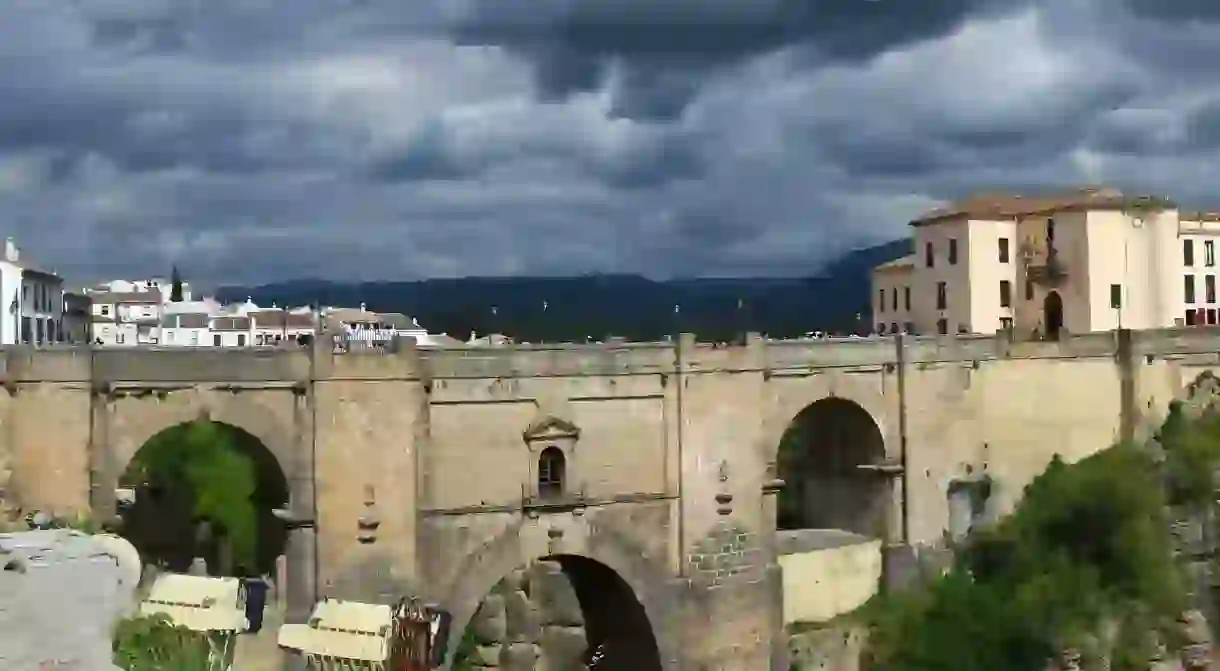The Coolest Neighbourhoods in Ronda, Spain

Ronda’s two halves are linked up a stunning 18th-century bridge that has made the town the third most-visited destination in Andalusia. Read on for our guide to the two fascinating neighbourhoods that make up Ronda.
El Mercadillo
Only in relative terms could the part of Ronda known as El Mercadillo (‘the little market’) be referred to as the ‘new’ part of town. It mainly dates from after the Christian reconquest of Ronda from the Moors in 1485 and occupies the northern side of the gorge that splits Ronda in two. Largely comprised of whitewashed buildings from the 16th, 17th and 18th centuries in the traditional Andalusian style, this is where most Rodeños live, so wandering its lively streets is a great way to take the town’s pulse. The barrio’s hub is the Mercado de Abastos, best visited mid-morning during the week, when locals exchange gossip whilst buying fresh meat, fruit and vegetables.

The key architectural attraction in this part of Ronda is the beautiful Plaza de Toros, or bullring. Completed at the end of the 18th century and designed by the same architect behind the monumental Puente Nuevo (see below), it is nowadays the setting for just one bullfight a year, held during the town’s August fiesta. It can be visited all year round, though, and also houses a bullfighting museum. This is the birthplace of the modern Spanish bullfight, as the spectacle’s two most important dynasties hailed from Ronda.
The El Mercadillo neighbourhood is also home to one of the most stunning parks in all of Andalusia. Located behind the bullring, the Alameda del Tajo’s central boulevard runs right down to the cliff edge, where you can admire the view from the so-called coño balconies (coño beinga Spanish swearword) jutting out over the void below. Their nickname is well deserved, because you’ll want a swearword to express your sense of vulnerability when stepping onto one of these precarious-looking platforms. If you need a stiff drink afterwards, head to either (or of course both) of the barrio’s two best tapas bars, La Alacena or El Lechugita.
Plaza de Toros de Ronda, 15 Calle Virgen de la Paz, Ronda, Spain, +34 952 87 41 32
Bar El Lechugita, 35 Calle Virgen de los Remedios, Ronda, Spain, +34 952 87 80 76
La Alacena, 3 Calle Nueva, Ronda, Spain, +34 952 16 14 79

La Ciudad
Connecting the ‘new’ part of Ronda with its oldest neighbourhood is the mighty (and mightily scary) Puente Nuevo, or ‘new bridge’. Construction of this incredible crossing took 40 years and was finally completed in 1793, by which point 50 workers had given their lives to the project.
It leads to the southern side of El Tajo into the original Moorish quarter of Ronda, which is known simply as La Ciudad, or ‘the town’. This is a beguiling cluster of gorgeous Mudejar-style buildings, attractive squares and winding cobbled streets that richly reward aimless meandering. One of its most notable attractions is the Casa del Rey Moro, or ‘house of the Moorish king’. The house itself was built in the 18th century and is currently closed to the public, but its tiered gardens are well worth a visit, and you can also take a 200-step staircase from here down to the bottom of the gorge.

This enchanting neighbourhood’s other key architectural attraction is the Santa Maria la Mayor church, an eloquent testament to the two cultures that have shaped Ronda. Construction started in 1485, the year that the Christians reclaimed the town from the Moors, and lasted for almost 200 years. Symbolically, the church was built on the site of what was then Ronda’s principal mosque, of which one wall and several elegant archways remain. The church fronts onto the lovely Plaza Duquesa de Parcent.
As is fitting for a neighbourhood that was once the heart of Moorish Ronda, La Ciudad also boasts some of the best-preserved Arabic baths in Spain. The beautiful Baños Arabas date from the 10th and 11th centuries and once served as a lively social hub, where locals from all levels of society would mingle in rooms of varying temperatures.
Baños Arabes, 11 Calle Molino de Alarcón, Ronda, Spain, +34 952 18 71 19














